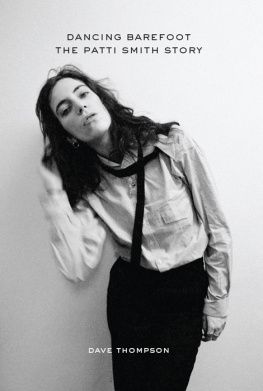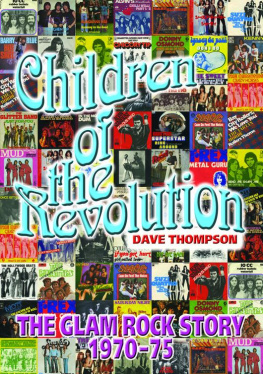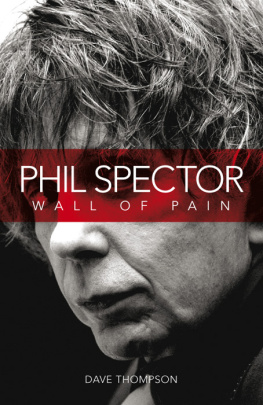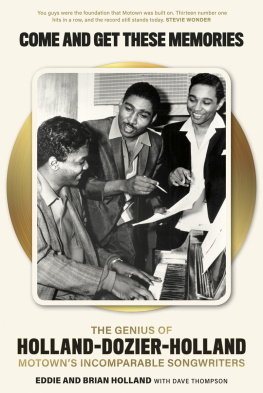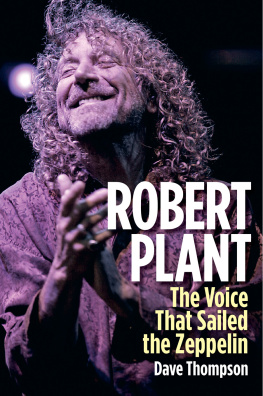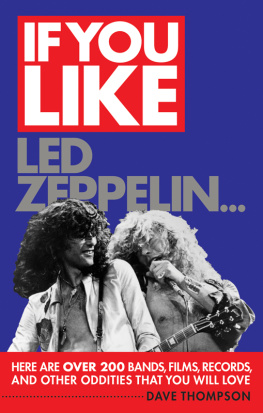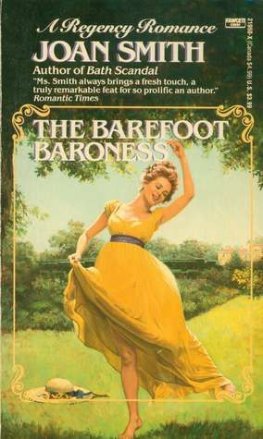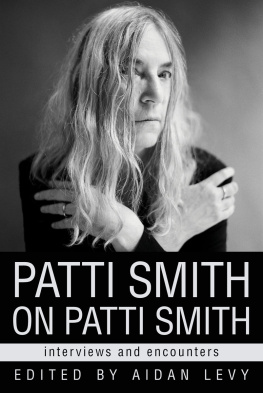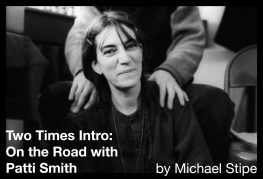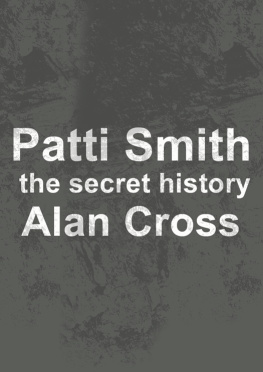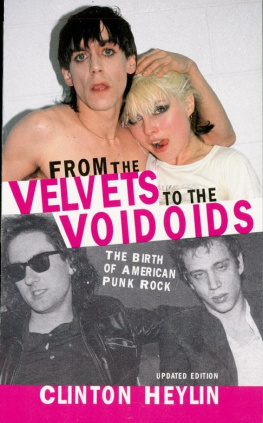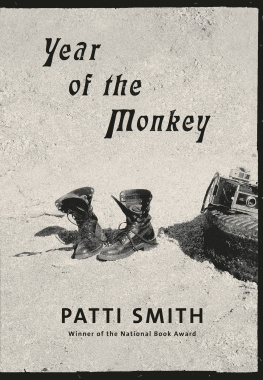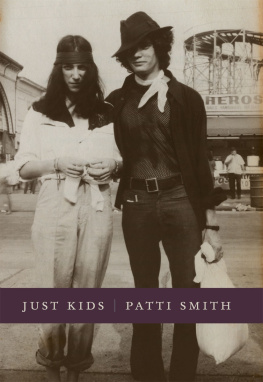
Library Of Congress Cataloging-In-Publication Data
Thompson, Dave, 1960 Jan. 3
Dancing barefoot : the Patti Smith story / Dave Thompson.
p. cm.
Includes bibliographical references and index.
ISBN 978-1-56976-325-4
1. Smith, Patti. 2. Rock musiciansUnited StatesBiography. I. Title.
ML420.S672T46 2011
782.42166092dc23
[B]
2011018859
Interior design: Jonathan Hahn
Portions of this book appeared previously in Goldmine magazine and the authors memoir Londons Burning: True Adventures on the Front Lines of Punk, 19761977.
2011 by Dave Thompson
All rights reserved
Published by Chicago Review Press, Incorporated
814 North Franklin Street
Chicago, Illinois 60610
ISBN 978-1-56976-325-4
Printed in the United States of America
5 4 3 2 1
For Cherry, who not only showed me what could be done but also gave me the resolve to do it.
You want me to dance more? Im like eighty years old.
Patti Smith, onstage in Oxford, England, October 2007
PREFACE
IN 1979, P ATTI Smith was on top of the world. Four albums and ten years into her career, she may not yet have been a household name, but she was at least named in all the households that mattered, and the previous years Because the Night (which she had cowritten with Bruce Springsteen) was already an FM immortal.
But no matter how well the world thought it knew her, she remained an enigma. Like Bob Dylan before her, she represented that precious moment when popular acclaim meshes with artistic precociousness until the two are utterly indivisible. Where, fans and critics alike would ponder, did the private Patti end and the public persona begin? Was there even a dividing line between the two? Or was her entire existence an ongoing art project whose true nature would only be revealed when it was complete?
That was the question I intended to ask her when, with the studious enthusiasm of a nineteen-year-old fanzine editor, I made my way into the sound check for what turned out to be the original Patti Smith Groups final London performance, in the hope of scoring an interview with her.
Unfortunately, Patti wasnt there.
I introduced myself to someone; it turned out to be her brother, Todd, who passed me on to somebody else; it was roadie Andi Ostrowe, and she allowed me to sit unobtrusively in a corner while she went to see if anyone could talk to me. A short while later, guitarist Lenny Kaye ambled over for an interview, which completely threw me, because he wasnt Patti. Neither was pianist Richard Sohl, who also sat in on the conversation, but I was too polite, or shy, to ask if she was around. It was obvious to me that she wasnt. The band sound-checked without her, and left the venue without her.
So did I, and although I wrote up my story and was pleased with the results, I dont believe I ever published it. Instead, it became the first pages in a scrapbook of impressions and memories that I collected over the years, fragments of which appear here for the first time.
This book is not intended to be an analytical biography of Patti Smith. Neither is it a straightforward summation of her life. Rather, it is something in between, a biography that places events in the cultural context of the time, as opposed to the sometimes trendier option of viewing everything through the prism of hindsight.
I have no intention of denigrating or ignoring Patti Smiths accomplishments over the past thirty years, for it is by those accomplishments that her continued influence and importance can best be measured. But as with so many other artists who served as forces for cultural change, Patti Smiths greatest influence emanates from the years during which she was still shaping herself and her career. As a result, the book might well feel chronologically top heavy: it is largely the story of a performer growing up in the New York City of the early-to-mid 1970s, while a large part of the city was growing up around her.
Emphasis on the term performerthis is not a tell-all biography. I have steered clear of Pattis private life: her friends away from her music, her lovers away from the spotlight, her family life. While the conscientious may read between a few of the lines and draw conclusions that do not always place Pattis actions in the kindest light, there are few scandals unearthed here, and no secret peeps behind closed doors. Such things are of interest to the personal biographer, but my goal is to document a career, because it is the career that defines the artist, not the Did she? / Would she? / Is she? tattle that almost every public figure contends with at some point in his or her career. Plus, I believe that Pattis audience have too much respect for her, as both a performer and a person, to care about such things.
Hence my decision to allow Pattis own words to guide the book, as opposed those of a multitude of onlookers, hangers-on, and casual acquaintances. (Some quotes, from her and others, have been lightly edited for clarity.) I dont especially care what scandal-hungry groupies or envious peers have to say about Patti, and I dont believe you would, either. These people knew of Patti, but they did not know her, and there is a profound difference between the two.
Patti wasand isboth smart and fortunate. She lives her private life in private and has constantly surrounded herself with people who help ensure that it remains there. Nevertheless, I was guided by some remarkable people. I met Ivan Kral, guitarist with the original Patti Smith Group, in 1991, as he worked to help birth the infant Seattle music scene: he was a member of a band called Sky Cries Mary then and was preparing a solo album called Native. I interviewed him for the Seattle Times, alerting the city to the presence of the genius in its midst, and again for Alternative Press. Along with Kayes thoughts and Sohls interjections from our 1979 interview, Krals words helped shape what this book would become.
So did those of many other interviewees, encountered over a number of years for a variety of publications and purposes: Stiv Bators, John Cale, Jim Carroll, Leee Black Childers, Jayne County (formerly Wayne County), Mick Farren, Richard Hell, Iggy Pop, Wayne Kramer, Hilly Kristal, Richard Lloyd, Ray Manzarek, Hilly Michaels, Elliott Murphy, Bobby Neuwirth, Nico, Johnny and Joey Ramone, Lou Reed, Mick Ronson, Rob Tyner, Cherry Vanilla, Tom Verlaine, and Tony Zanetta.
Other friends and associates played their own part in this book: my editors Yuval Taylor and Devon Freeny, Amy Hanson, Jo-Ann Greene, Theresa K., Geoff Monmouth, Tobias Wilcox, Trevor and Oliver, and many more.
Yet when it came to writing this book, I discovered that the only words that could really tell Patti Smiths stories were Pattis own. The people around her at different times in her life convey context and meaning, of course. But only Patti knew what she was saying, thinking, reacting to, and causing to happen as her career unfolded, and it was the unfolding of that career that I was most intrigued by.
Sometimes she exaggerates; sometimes she deceives. Discussing some of her earliest musical memories, for example, she once shaved five years off her actual age in order to press home a particular point. I addressed these discrepancies when I came across them, but I also endeavored never to lose sight of the point that she was making, particularly since the biographical details as she related them were often immaterial to begin with.

